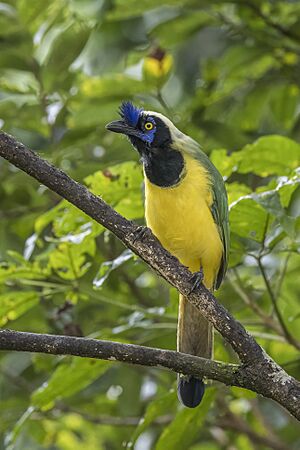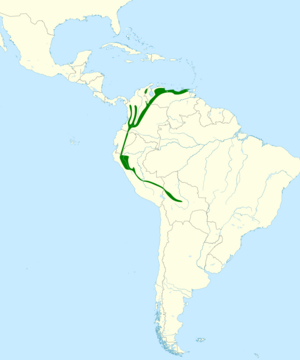Inca jay facts for kids
Quick facts for kids Inca jay |
|
|---|---|
 |
|
| in Colombia | |
| Conservation status | |
| Scientific classification | |
| Genus: |
Cyanocorax
|
| Species: |
yncas
|
 |
|
The Inca jay, also known as the querrequerre, is a colorful bird from the group called New World jays. This bird lives in the Andes mountains of South America.
Contents
Discovering the Inca Jay
The Inca jay was first described by a French scientist named Georges-Louis Leclerc, Comte de Buffon in 1775. He wrote about it in his book Histoire Naturelle des Oiseaux.
Later, in 1783, a Dutch scientist named Pieter Boddaert gave the bird its scientific name, Corvus yncas. This is called a binomial name, which means it has two parts. The first part is for the group (genus), and the second part is for the specific animal (species).
The Inca jay is now part of a group of 17 jay species. This group is called Cyanocorax. The name Cyanocorax comes from ancient Greek words meaning "dark-blue" and "raven." The word yncas comes from the Incas, who were people living in Peru a long time ago.
Different Types of Inca Jays
There are five main types, or subspecies, of the Inca jay. They are a bit different depending on where they live:
- C. y. galeatus (Ridgway, 1900) – Found in western Colombia. It has a larger crest on its head.
- C. y. cyanodorsalis (Dubois, 1874) – Lives east of the Andes in Colombia and northwest Venezuela. This type is smaller and has a dark blue crest. It also has a white stripe on its forehead and a dark green back.
- C. y. guatimalensis (Bonaparte, 1850) – Found in the mountains of northern Venezuela. It has a shorter crest and less blue color overall. Its legs and eyes are brownish.
- C. y. yncas (Boddaert, 1783) – This is the original type. It lives from southwestern Colombia to eastern Ecuador, Peru, and central Bolivia.
- C. y. longirostris (Carriker, 1933) – Found along the Marañon Valley in northern Peru. This type is larger than the original Inca jay.
Some scientists used to think the Inca jay and the green jay (from North America) were the same species. However, a study in 2010 looked at their DNA. It found that they are likely separate species, but more research is needed to be sure.
What the Inca Jay Looks Like
The Inca jay is about 29.5 to 30.5 centimeters (about 11.6 to 12 inches) long. Its head can look mostly white, with blue only on the front crest and the back of its neck.
It has a black patch under its chin that goes up the sides of its head. There's also a black stripe through its eye and another one above it. Its chest and belly are usually bright yellow. The upper parts of its body are a rich green color. The bird's eyes are a bright yellow.
Inca Jay Sounds
Like most jays, the Inca jay can make many different sounds. Its most common call sounds like "rassh-rassh-rassh." It also makes many other unusual noises. One of its calls even sounds like an alarm bell ringing!
Where Inca Jays Live
The Inca jay lives in the Andes mountains. Its home stretches from Colombia and Venezuela south through Ecuador, Peru, and Bolivia.
How Inca Jays Live
Reproduction and Family Life
Inca jays usually build their nests in trees or in thorny bushes. The female bird lays three to five eggs. Only the female sits on the eggs to keep them warm until they hatch. However, both parents work together to take care of the young birds.
Sometimes, in Venezuela, a different bird called a giant cowbird will lay its eggs in an Inca jay's nest. This is called "nest parasitism." The cowbird's eggs hatch, and the Inca jay parents end up raising the cowbird chicks.
What Inca Jays Eat
Inca jays eat a variety of foods. Their main diet includes insects and other small creatures (arthropods). They also eat small animals with backbones (vertebrates), seeds, and fruit.


